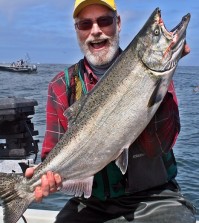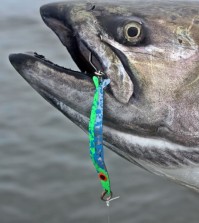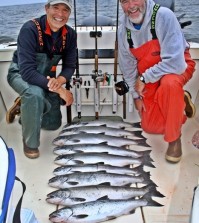Wild and Windy Willipa

A few years back a friend of mine excitedly referred to the months of August and September as Magic Time for Northwest fishermen, and he was absolutely right. There are some many salmon-fishing opportunities this time of year that it’s sometimes difficult to decide which direction to go when you trailer your boat out of the driveway in the morning. Well, if Willapa Bay isn’t already on your list of choices, let me make the decision just a little tougher for you!
Willapa is a place where you can hook your trophy king of a lifetime, and it’s only a few hours from the Puget Sound population centers. Fish in the high-thirties, forties and even fifty-pound class come from Willapa most years, and while you’re looking for that wall-hanger there are enough “little” 12- to 20-pound Chinook to keep you occupied. By early September good numbers of Coho start rolling in to add variety, and the majority of both kings and silvers are hatchery fish, bound for the Willapa, Nemah and Naselle hatcheries, meaning that clipped keepers are the rule, not the exception.
And, to make things even better when the bite is on, Willapa is one of few saltwater fisheries where the daily salmon limit is three—not two—adult fish.
By now you’re probably asking, “What’s the catch?”
Well, the catch is WEEDS. Tons of eel grass, spartina and other aquatic vegetation often clog the bay and sometimes makes the salmon fishing look a lot like that heavy-cover bass fishing we might see on the Butt-Crack Outdoors Network. All that “grass,” of course, tangles in lines, drapes over sinkers, knots itself around attractors and hides baits and lures in a thick web of greens, yellows and browns. Sometimes it’s so thick and persistent that you can’t fish at all, and most of the time it calls for continuous tackle maintenance.
The other down side to the Willapa sport fishery is the Willapa commercial fishery, which begins in mid-September and clogs the bay with gill-nets. It’s best to get your licks in before the gill-netter show up.
The Willapa fishery started to become well-known in the late-eighties, when hatchery Chinook returns to the Willapa tributaries soared to 60,000 and even 70,000 fish a year, and folks like Tony Floor started fishing it and talking it up. Back then, when the beach fishery out at the northwestern corner of the bay was really the only sport fishery at Willapa, five boats on the water would have been a crowd, but as word got out about the good fishing and the size and energy of those fresh-from-the-Pacific kings, the Willapa sport fleet grew steadily, and eventually more and more people realized that you didn’t have to live life on the edge (of the surf) to catch husky kings at Willapa. Once people realized that it was possible to catch salmon and stay relatively safe a little farther inside the bay, the fishery quickly evolved into what it is today.
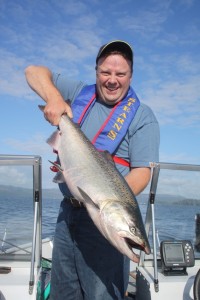 A hard-core few, including Floor, though, still like to tempt fate in order to get a jump on the rest of the Willapa crowd, so you’ll find them setting up out at the edge of Cape Shoalwater, stern toward the surf in 10 to 15 feet of water, fishing a plug-cut herring behind a drop sinker at the start of the flood, intercepting big, bright kings that left the ocean not days, hours or even minutes before, but just a few seconds ago!
A hard-core few, including Floor, though, still like to tempt fate in order to get a jump on the rest of the Willapa crowd, so you’ll find them setting up out at the edge of Cape Shoalwater, stern toward the surf in 10 to 15 feet of water, fishing a plug-cut herring behind a drop sinker at the start of the flood, intercepting big, bright kings that left the ocean not days, hours or even minutes before, but just a few seconds ago!
And the beach fishery offers other incentives besides ocean-fresh fish. For one thing, salmon bound for all three river systems may pass through the deep channel at this northern bay entrance, while the main bay fishery targets primarily Willapa River-bound fish. Also, when gillnetters fill the bay in mid-September, sport fishing inside becomes difficult at best, but anglers brave enough to fish the beach can pick off late-run kings and bright silvers before they reach the nets.
The best-known and most popular section of salmon-fishing water in the bay these days is the two-mile stretch of river channel running from buoy 2 (about three-quarters of a mile south-southeast of the Tokeland Marian entrance) east (inland) to buoy 10. On a typical day between about August 20 to the middle of September, perhaps 95 percent of the fishing pressure will be concentrated on this part of the bay, and during a weekend that can mean 100 boats or more. The short distance between buoys 8 and 10 is especially popular; because it may produce fish throughout much of the day, so many anglers simply circle back and forth between the two buoys for hours on end. And when there’s a hot bite here, it can get more than a little hectic with so many boats and so many anglers within easy cussing distance of each other.
Prime time to fish this lower two miles of the main bay is during the last two hours of the flood tide and into the first hour or two of the ebb, and depending on the size of the tide and the timing of the runs of fresh fish surging in from the ocean, this two- to three-hour period might provide the only real salmon action of the day. That’s one of the main reasons why the Willapa Bay salmon fishery isn’t more popular than it already is, especially among anglers who live beyond southwest Washington; some anglers just aren’t willing to travel two or three hours to fish from daylight to dark in a spot where the bite is likely to last only a couple of hours.
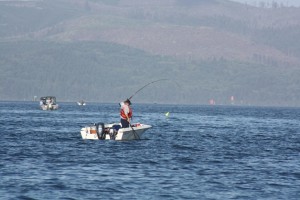 You just might, however, prolong your fishing opportunity by working your way upriver with the migrating fish and getting away from the crowds in the main part of the bay. Fish are often caught between buoys 13 and 17 and even farther upriver between the 19 and 24 buoys. Remember, though, that the channel gets narrower as you move upstream and as the tide ebbs, so there’s less margin for error when it comes to boating this stretch.
You just might, however, prolong your fishing opportunity by working your way upriver with the migrating fish and getting away from the crowds in the main part of the bay. Fish are often caught between buoys 13 and 17 and even farther upriver between the 19 and 24 buoys. Remember, though, that the channel gets narrower as you move upstream and as the tide ebbs, so there’s less margin for error when it comes to boating this stretch.
There’s nothing complicated, mysterious or technical about Willapa Bay salmon- fishing methods; it’s the kind of straightforward, shallow-water trolling that often allows novice salmon anglers with 1960s-vintage tackle the same chance for success as the hard-core regular sporting state-of-the-art rods, reels and line.
Most of the fishing is confined to the main river channel, where depths range from 12 to 30 feet, so you don’t need downriggers to take a bait or lure down into the strike zone. Most Willapa veterans use four- to eight-ounce sinkers to keep their gear down where they want it, which usually is about a foot off the deck. Cannonballs on 12- to 16-inch droppers are standard, and they can be hung either off sliders or from three-way swivels. Using a dropper not only keeps a rig fishing right at eye level to any big king cruising along the bottom, it also keeps baits out of reach from the thousands of smallish Dungeness crabs that are scuttling along the Willapa Bay bottom. The third benefit of a dropper is that it will catch a certain percentage of the eel grass and other weeds that would otherwise tangle around hooks, baits and lures.
Below the sinker most Willapa Bay salmon anglers use an attractor, and the two used more than all others combined are the Big Al’s Fish Flash and the KoneZone flashers. Both provide great flash and visibility ahead of a bait or lure and both produce little drag while spinning enticingly through the water. There’s a wide range of opinion as to what size and color combinations work best, but there’s a lot to be said for getting as much attraction as possible ahead of your bait when fishing Willapa’s somewhat murky, often weed-filled waters.
Proper distance between sinker and attractor, by the way, is another topic of debate among Willapa salmon anglers. A majority seem to prefer keeping the sinker about two feet ahead of the flasher, while quite a few folks hang their drop sinker off a slider that butts right down against the swivel at the top of the flasher. Those who go the latter route say that dropping the sinker right off the nose of the flasher ensures that their rig is at precisely the desired depth.
Below the attractor most anglers fish herring or anchovy baits, with whole or plug-cut herring topping the list. Plug-cut baits are a little easier to rig for most anglers, but they are also more likely to be affected by constant battering against the bottom and the jungle of weeds, ruining their action and reducing their effectiveness. In recent years I’ve noticed more and more Willapa regulars fishing whole anchovies and whole herring in plastic bait “helmets,” which no doubt prolongs the effective life of their baits.
Leader length between attractor and bait is another matter of preference. Some like a longer leader of six to even seven feet, but four feet is probably average. A few of us, though, like to keep our baits and flashers closer together. I shorten it up to about 32 inches, in the belief that salmon drawn to my attractor in Willapa’s often-murky waters are more likely to spot my bait if it’s right behind the attractor than they will if the two are five or six feet apart.
However you choose to rig your sinker, flasher and bait, though, use plenty of swivels throughout the system. Eel grass, spartina strands and other vegetation wraps itself around every component of your terminal rig as you fish, and the more swivels you have in your system the better you can counteract the weeds and keep everything working smoothly and effectively.
 The effectiveness of your swivels also can be increased if you use something to shield them from the vegetation. Many Willapa anglers slide plastic “golf tee” bodies over the top ends of their swivels to ward off some of the weeds, while others use the clear-plastic Weed Guard swivel protectors manufactured by Oregon Tackle. These little “swivel condoms” do a great job of keeping those fine strands of spartina from wrapping around bead chains and rendering them useless.
The effectiveness of your swivels also can be increased if you use something to shield them from the vegetation. Many Willapa anglers slide plastic “golf tee” bodies over the top ends of their swivels to ward off some of the weeds, while others use the clear-plastic Weed Guard swivel protectors manufactured by Oregon Tackle. These little “swivel condoms” do a great job of keeping those fine strands of spartina from wrapping around bead chains and rendering them useless.
By now there should be little doubt that when you fish Willapa Bay, you’re likely to encounter weeds, and you need to do everything you can to keep them off your hooks and other terminal tackle or you’re not going to catch many fish. Some periods of the day and some parts of the bay aren’t as prone to weed problems as others, but there is always some eel grass and other vegetation suspended in the water, so weeds are always something to think about. Even in “low-weed” situations Willapa anglers who don’t reel in and check their gear at least once every 15 minutes are asking for trouble, and I like to stick to a 10-minute schedule as much as possible. When there are lots of weeds around you may have to reel in and clean them off every couple of minutes.
Weeds are the most common problem that Willapa anglers face, but some days dogfish are right up there vying for biggest-pain-in-the-butt honors. I’ve had my share of three-dog days, and they’re more likely to occur when you’re fishing out near the western end of the bay and when there are abnormally high concentrations of anchovies around.
Most anglers spend their fishing time right in the Willapa River channel, because it’s the logical travel route, at least for kings. But don’t be afraid to explore the shallower waters along the main channel’s edges. Not only will you find fish there, but you’ll also have to fight less boat traffic and be able to explore at more your own pace. It’s not unusual to pick Willapa kings out of eight to 12 feet of water, and when you do you’ll usually have plenty of room to fight ‘em. That’s good, because when hooked in water that shallow your average Chinook quickly becomes a real screamer!
Every high tide during the last several weeks of summer brings fresh fish into Willapa Bay, which explains why the hot bite usually occurs at the end of the flood and into the start of the ebb, but some tide series produce better fishing than others, and that gives this fishery a true hit-or-miss reputation. Some anglers like to time their Willapa trips to coincide with the biggest tides of the season, but those extreme tides also tend to tear a lot of eel grass loose and wash it back and forth through the bay, sometimes creating nightmare fishing conditions. Higher tides may draw more fish in from the ocean, but other factors, such as water temperature, bait abundance, or late-summer rains that increase river flows, can also play a big part in the number of fish that move into the bay on any particular tide. There isn’t any “sure-thing” timing strategy, and the anglers who score most consistently are those who fish it several times a week throughout the season so that they’re on hand when it starts to pop.
Harley Graves, one of my regular fishing buddies, demonstrated the value of persistence to me a few years ago, when he took several family members to Willapa for a week in early September. There was a series of early morning and early evening flood tides that week, but even though conditions were favorable, the Graves crew averaged only a fish or two each of the first three days. Then, boom, things went crazy on Thursday, and I got a mid-morning phone call featuring the sounds of screaming reels and giggling fishermen in the background. The running score was five kings in the boat and a double in progress, and the parting advice was something like, “Leave now and be here for the evening flood. Click.”
I was on the water four hours later, and as the Graves family put their tenth and final king in the boat, the crew of the SS Rudnick was busy wrestling with one of the seven salmon we would hook during a two-hour evening bite.
Willapa certainly isn’t as susceptible as the nearby ocean to the whims of nature, but mornings can be foggy on the bay late in the summer, and it can drop in on you in a hurry. There will be days when you need a GPS to keep your boat out of the mud flats.
While fog may cause problems for Willapa Bay anglers early in the day, the wind often picks up in the afternoon, making for tougher trolling and sometimes semi-dangerous boating conditions. As is typical along the Pacific coast, it usually starts as a soft breeze as the land heats and the warm air begins to rise an hour or two after noon. By 3:00 or 4:00 p.m. the bay can be a sea of whitecaps, and the anglers in those little 14-footers with 20-horse outboards—at least the smarter ones—have already found their way back to wherever they’d launched that morning. Those of us with bigger boats and/or smaller brains are usually rewarded with calmer seas as afternoon turns to evening.
If you’ve never been to Willapa, take Highway 101 to Raymond and turn west on Highway 105 to reach Tokeland and the north side of the bay. Access from the south side is via the lower Willapa River at South Bend, southwest of Raymond.
There’s a two-lane ramp at Tokeland Marina, with a launching float and lots of parking on a gravel lot. The marina also has moorage, RV facilities, bait, ice and snacks, with lodging and a couple of restaurants nearby. Lunch fee is $5. Call Tokeland Marina, 360-267-2888. A Department of Fish and Wildlife ramp at the mouth of Smith Creek is free but requires a short run downriver to the bay. Larger boats may have trouble passing under the Smith Creek Bridge on a high tide. The ramp has a large gravel parking area and pit toilets.
A one-lane ramp off Highway 101 at the west end of South Bend has a large launching float and a parking area that has been expanded a couple of times in recent years. Launch/parking fee here is $5. Lodging and restaurants are close to the ramp.




